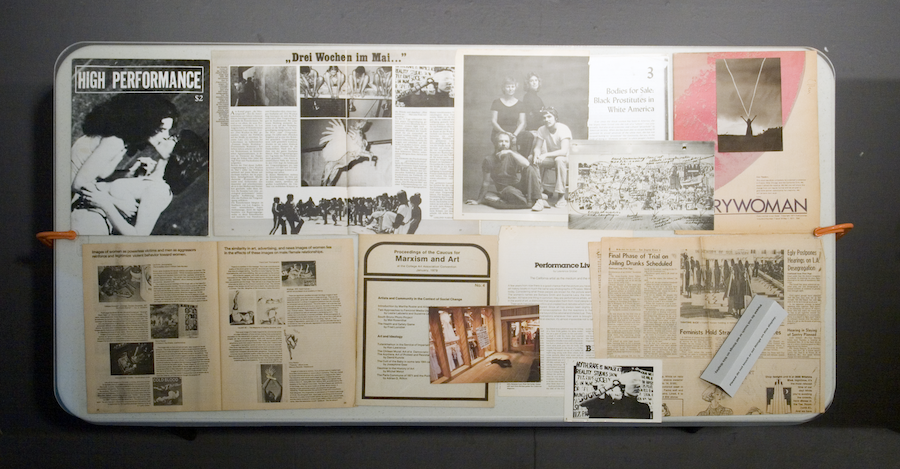Suzanne Lacy Salutes ‘a Force in LA for Feminist, Gay and Performance Art’
Suzanne Lacy discusses the malleable meaning of the archive with the Getty’s Glenn Phillips
Suzanne Lacy discusses the malleable meaning of the archive with the Getty’s Glenn Phillips

Glenn Phillips Suzanne, the first time we did an interview was in 2007 at 18th Street Arts Center where you and Leslie Labowitz-Starus had installed ‘The Performing Archive’. You turned the archive into an installation and activated it by having people come in and use it. It was highly visual, interactive and a functional archive – all at once.

Suzanne Lacy Leslie and I collaborated in the late 1970s on performances about violence against women. We wanted to look back at these issues, to look at the way performance art transforms over time, and we were also looking at understandings of gender in contemporary art. Then in 2007, we were discussing how feminist art was being rethought in terms of new theories and cultural understandings, including issues of race, poverty and so on. I thought it would be interesting to challenge received narratives in art discourse based on what you might actually find in a feminist artist’s archive. I wanted to foreground both the importance of archives for women’s work and direct access to archives as a learning tool. We invited 12 young women artists and scholars and said, ‘Go through the archive and see what’s of interest to you.’ I just video taped them responding to what they selected. I didn’t correct them. I wanted to illuminate their process of discovery, their interpretations. We stuck the videos in between the boxes so visitors to the installation could see the archives, along with these young women trying to understand how we actually thought about the work.

GP 18th Street Arts Center was the venue. Could you talk about their openness to having projects like this?
SL 18th Street has been a force in LA for feminist, gay and performance art. They’ve been crucial for so many areas of social, political, exploratory and avant-garde kinds of thinking. And of course, it’s been a residency for artists from all over the world. I don’t remember when 18th Street came into my consciousness; it was always part of the LA performance scene.
GP One of the more remarkable developments in your career is the way you’ve used your archive to create these extraordinary, spatially complex installations. It really struck me in your recent retrospective at San Francisco Museum of Modern Art, the way your projects unfold over time and space. But you have many other kinds of space that are important to you. One of them is social space and how people understand the issues you confront in our present moment. Another is the media space, and how public communication happens around these same issues, whether that be television in the 1970s or social media today.

SL My work is idea-driven and hard to pin down as a singular aesthetic form. It’s very visual, but it’s also informed by the context in which it operates, the social issues and how they align with my own values. Exhibitions of temporal works have changed too. In the 1970s we thumbtacked photographs on the wall and considered that as an effective way to communicate a performance produced earlier. Each time we exhibited, we configured the work to fit the space we had. But now it’s important to create a ‘final’ version, an artwork that represents the nature and context of the original work, one that responds to current technologies and ideas, where you can say: this is that work.
GP When performance enters the museum in its ‘final form’, it often matches the era in which the museum acquires it. In the era of big photography, for instance, people started blowing up their documentation to match. I think performance has no choice but to react to the era it’s in.
SL I agree that once a work’s acquired, you should probably leave it the way it is. But just because a piece was shown on a small television in the 1970s doesn’t mean it can’t be a large projection now. It’s my work. While I’m alive, I can show it the way I want. That’s the malleability of contextual and time-based art.

GP That can be a challenging idea for museum professionals. The acquisitions side of me never wants to see a piece change. But the exhibitions side of me – well that’s a different story because you want to do the very best show possible, even if that means breaking some rules. And your work is always a prompt for people to engage with an idea. If that’s the ambition, then it needs to be presented in a way that can get that idea across to the viewer.
SL Right. What draws me to art is the idea. In ‘The Performing Archive’ Leslie and I were exploring very current ideas about art and social context. As I’ve been focusing on exhibitions lately, I’m hauling projects out of my archives and considering how I might finally represent them. Like Cinderella in a Dragster, a performance I did in 1976. Maybe I need to build a hot rod? What will be its final form?
This article first appeared in Frieze Week, February 2023 under the headline ‘Always on Time'
Main image: Suzanne Lacy and Leslie Labowitz, The Performing Archive: Restricted Access, 2007. Photograph: Kelly Akashi
























